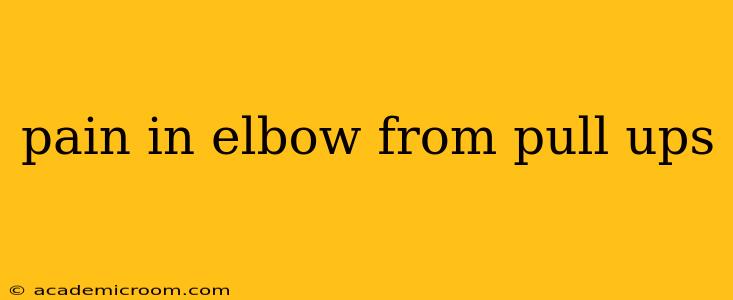Pull-ups are a fantastic exercise for building upper body strength, but they can also lead to elbow pain if not performed correctly. Many factors contribute to this common problem, ranging from improper form to underlying medical conditions. This comprehensive guide will explore the causes of elbow pain from pull-ups, effective prevention strategies, and appropriate treatment options. Understanding these elements is crucial for continuing your fitness journey without compromising your health.
What Causes Elbow Pain After Pull-Ups?
Elbow pain following pull-ups often stems from overuse, improper form, or underlying conditions. Let's delve into the specific culprits:
-
Golfer's Elbow (Medial Epicondylitis): This condition involves inflammation of the tendons on the inside of your elbow, often caused by repetitive gripping and flexing actions during pull-ups. Pain is typically felt on the inner elbow and can radiate down the forearm.
-
Tennis Elbow (Lateral Epicondylitis): This is the inflammation of the tendons on the outside of your elbow, frequently triggered by repetitive wrist extension and supination (rotating your palm upward), actions also involved in pull-ups, particularly if your grip is incorrect. Pain is usually felt on the outer elbow and may extend down the forearm.
-
Overuse Injuries: Performing too many pull-ups, especially without adequate rest, can lead to tendonitis, muscle strains, or ligament sprains. Your elbows are subjected to considerable stress during this exercise.
-
Poor Form: Incorrect pull-up technique, such as using too much momentum or not engaging the right muscles, puts excessive strain on your elbows. This can exacerbate existing conditions or create new ones.
-
Underlying Medical Conditions: Conditions like arthritis, bone spurs, or nerve entrapment can also contribute to elbow pain during or after pull-ups.
How Can I Prevent Elbow Pain From Pull-Ups?
Preventing elbow pain is crucial. Implementing these strategies significantly reduces your risk:
-
Proper Warm-up: Always warm up before any workout, especially one involving intense movements like pull-ups. This could include light cardio, dynamic stretching (arm circles, wrist rotations), and specific exercises to activate the muscles involved in pull-ups.
-
Correct Form: Focus on maintaining proper form throughout the entire movement. Engage your back muscles and avoid swinging your body or using momentum. A slow, controlled movement is key. If unsure about your form, seek guidance from a qualified fitness professional.
-
Progressive Overload: Gradually increase the number of pull-ups you perform over time. Avoid sudden increases in intensity or volume, which can overwhelm your elbows. Start with assisted pull-ups or negative pull-ups if needed and progressively increase the difficulty.
-
Rest and Recovery: Allow your body adequate time to recover between workouts. Don't perform pull-ups every day. Incorporate rest days into your training schedule to prevent overuse injuries.
-
Strengthening Supporting Muscles: Focus on strengthening the muscles surrounding your elbows, including your forearms, biceps, and triceps. This will improve stability and reduce strain on your elbows during pull-ups.
-
Listen to Your Body: Pay attention to your body and stop if you experience pain. Ignoring pain can lead to more significant injuries.
What Should I Do if I Have Elbow Pain From Pull-Ups?
If you experience elbow pain, take the following steps:
-
Rest: Avoid activities that aggravate the pain. This often means taking a break from pull-ups.
-
Ice: Apply ice to the affected area for 15-20 minutes at a time, several times a day. This will help reduce inflammation.
-
Over-the-Counter Pain Relief: Nonsteroidal anti-inflammatory drugs (NSAIDs) like ibuprofen or naproxen can help manage pain and inflammation.
-
Physical Therapy: A physical therapist can provide personalized exercises and treatments to address the underlying cause of your pain.
-
Medical Consultation: If the pain persists or worsens, consult a doctor or orthopedic specialist. They can diagnose the problem and recommend appropriate treatment, which may include corticosteroid injections or, in severe cases, surgery.
Can I Still Do Pull-Ups If I Have Elbow Pain?
If you have elbow pain, it's crucial to modify your routine or take a break from pull-ups entirely. Pushing through pain will likely worsen the condition. Consider alternative exercises that target similar muscle groups without stressing your elbows. Once the pain subsides, you can gradually reintroduce pull-ups, focusing on perfect form and progressive overload.
What Exercises Can I Do Instead of Pull-Ups?
Several exercises can provide similar benefits without putting excessive strain on your elbows:
-
Rows (various types): These are excellent for building back and arm strength.
-
Lat Pulldowns: A machine-based exercise that allows for controlled movements.
-
Bicep Curls and Tricep Extensions: Isolate the biceps and triceps to build strength without the added stress of pull-ups.
Remember, consulting a healthcare professional is always recommended for persistent or severe elbow pain. They can provide accurate diagnoses and personalized treatment plans. Your fitness journey should be enjoyable and safe; prioritizing your health ensures long-term success.
